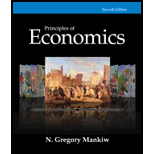
Subpart (a):
Marginal productivity and its relevance.
Subpart (a):
Explanation of Solution
In this given scenario, fisherman is the only variable factor. When other things remain the same increasing the number of fisherman leads to reduce the productivity which is known as diminishing marginal productivity.
In the fish firm, all the factors can be varied according to the requirement. Thus, marginal productivity is constant for the fisherman in the firm.
Concept introduction:
Marginal product: Marginal product refers to an additional product in the total product due to a change in one unit of labor.
Diminishing marginal product: Diminishing marginal productivity refers to the increase in output at a slower rate as an additional unit of input increases.
Subpart (b):
Number of fishing person.
Subpart (b):
Explanation of Solution
Minimum number of fish should catch is 2 per day. The number of fisherman fishing in the lake can be calculated as follows.
Thus, the number of fisherman catching fish in the lake is 4. Remaining one fisherman is working in the firm. Total number of fish catching is 10 units
Subpart (c):
Marginal productivity and its relevance.
Subpart (c):
Explanation of Solution
Total number of fish can be calculated as follows.
Substitute the respective values in equation (1) to calculate the total number of fish at 1 unit of fisher man.
Total fish is 5 units.
Marginal productivity can be calculated as follows.
Substitute the respective values in equation (2) to calculate the marginal productivity of fish at 2 unit of fisher man.
Total fish is 5 units.
Table -1 shows the marginal productivity of fisher in the lake that obtained by using equation (1).
Table -1
|
Total fisherman (a) |
Catching fish per person
| Total fish | Marginal productivity |
| 1 | 5 | 5 | - |
| 2 | 4 | 8 | 3 |
| 3 | 3 | 9 | 1 |
| 4 | 2 | 8 | –1 |
| 5 | 1 | 5 | –3 |
Profit maximizing output is occurred at the point where the marginal revenue is equal to or greater than the marginal cost. Since marginal productivity is closer to 2 at the number of fisherman is 2, two fishers should be catch the fish in lake. Remaining 3 fishermen should work in the farm. And remaining 3 people should produce fish the farm. Total production of fish can be calculated as follows.
Thus, total number of fish is 14.
Concept introduction:
Marginal product: Marginal product refers to an additional product in the total product due to a change in one unit of labor.
Diminishing marginal product: Diminishing marginal productivity refers to the increase in output at a slower rate as an additional unit of input increases.
Subpart (d):
Marginal productivity and its relevance.
Subpart (d):
Explanation of Solution
The value of tax should be equal to the marginal productivity of the fisherman. The marginal productivity of fishermen is 2 (Fisherman produces fish in the farm). Thus, the tax should be equal to $2. The marginal productivity for fisher man who working in the lake is equal to or greater than the tax amount $2. Thus, two fisher man catching fish in lake and rest of the fisherman produces fish in the farm.
Concept introduction:
Marginal product: Marginal product refers to an additional product in the total product due to a change in one unit of labor.
Diminishing marginal product: Diminishing marginal productivity refers to the increase in output at a slower rate as an additional unit of input increases.
Subpart (e):
Number of fish per person
Subpart (e):
Explanation of Solution
Number of fish per person as per the policy can be calculated as follows.
Thus, one fisherman gets 2.8 units of fish.
The person work in the farm produces only 32 units of fish and now receives additional 0.8 units of fish. On the other hand, the fisherman who works in the lake catches 4 per person. Now they are losing 1.2 units of fish. The policy makers opinion is that if there is no restriction, then fisherman in the lake would catch only 2 units of fish per fisherman.
Want to see more full solutions like this?
Chapter 11 Solutions
Principles of Economics, 7th Edition (MindTap Course List)
- how commond economies relate to principle Of Economics ?arrow_forwardCritically analyse the five (5) characteristics of Ubuntu and provide examples of how they apply to the National Health Insurance (NHI) in South Africa.arrow_forwardCritically analyse the five (5) characteristics of Ubuntu and provide examples of how they apply to the National Health Insurance (NHI) in South Africa.arrow_forward
- Outline the nine (9) consumer rights as specified in the Consumer Rights Act in South Africa.arrow_forwardIn what ways could you show the attractiveness of Philippines in the form of videos/campaigns to foreign investors? Cite 10 examples.arrow_forwardExplain the following terms and provide an example for each term: • Corruption • Fraud • Briberyarrow_forward
- In what ways could you show the attractiveness of a country in the form of videos/campaigns?arrow_forwardWith the VBS scenario in mind, debate with your own words the view that stakeholders are the primary reason why business ethics must be implemented.arrow_forwardThe unethical decisions taken by the VBS management affected the lives of many of their clients who trusted their business and services You are appointed as an ethics officer at Tyme Bank. Advise the management regarding the role of legislation in South Africa in providing the legal framework for business operations.arrow_forward




 Microeconomics: Private and Public Choice (MindTa...EconomicsISBN:9781305506893Author:James D. Gwartney, Richard L. Stroup, Russell S. Sobel, David A. MacphersonPublisher:Cengage Learning
Microeconomics: Private and Public Choice (MindTa...EconomicsISBN:9781305506893Author:James D. Gwartney, Richard L. Stroup, Russell S. Sobel, David A. MacphersonPublisher:Cengage Learning Macroeconomics: Private and Public Choice (MindTa...EconomicsISBN:9781305506756Author:James D. Gwartney, Richard L. Stroup, Russell S. Sobel, David A. MacphersonPublisher:Cengage Learning
Macroeconomics: Private and Public Choice (MindTa...EconomicsISBN:9781305506756Author:James D. Gwartney, Richard L. Stroup, Russell S. Sobel, David A. MacphersonPublisher:Cengage Learning





